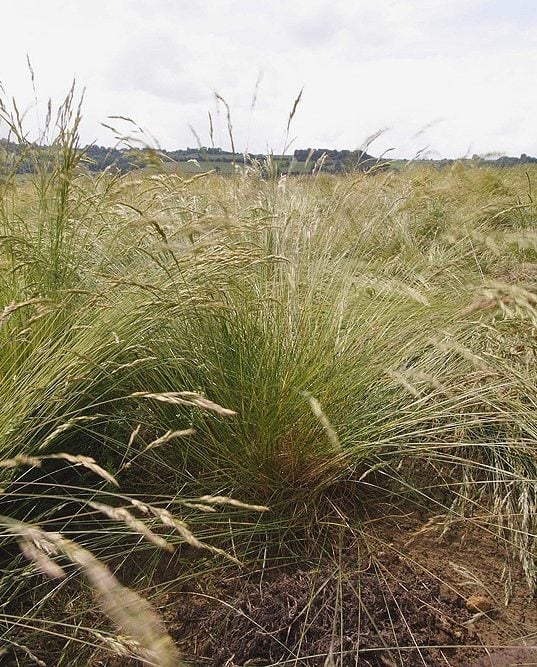Description
Red fescue is a fine-leaved perennial grass of medium height and vigour. Its fine, bristle-like, mid to dark green glossy leaves are probably its most characteristic feature. Its heads are branched typically growing to less than 70cm in height. Red fescue is extremely variable species which can grow in dense tufts or spread out by rhizomes to form patches or carpets of fine leaves. Strong-creeping varieties of red fescue have more vigorous spreading rhizomes and typically form open patches, rather than dense tufts. They are usually classified as Festuca rubra subspecies rubra.
Habitat Information
Red fescue is a widespread grass species and is a component of many botanically rich grassland communities. It is one of the most frequent grasses of unimproved traditional meadows, along with crested dogs tail and common bent. It is also common in all kinds of grassy habitats, including banks, verges, pastures, saltmarshes, sea-cliffs, sand dunes, hill grasslands, mountain slopes and rock ledges.
It will grow in all but the most acid or waterlogged soils. It is a relatively slow growing and stress tolerant grass; it is particularly suited to growing on free draining, low fertility, neutral to calcareous soils.
Growing Information
Red fescue seed can be sown at any time of the year when soil conditions are suitable. It can be moderately quick to germinate from sowing, but being a relatively slow-growing grass, the small fine leaved seedlings will take some time to grow before they reach full size and cover.
Once established, red fescue plants are very long-lived and able to withstand considerable nutrient and drought stress. They are able to spread effectively by creeping vegetative rhizome growth, so are not dependant on seed to regenerate or colonise gaps. In finer grassland red fescue forms a valuable structural component at the base of the sward.
Where conditions favour it over other grasses red fescue does have the potential to become dominant. Long-term fescue dominance can be avoided by sowing a balanced mixture including companion grasses like crested dogstail, and by good ongoing management.
Red fescue is tolerant of frequent close mowing or grazing and responds by producing a fine dense sward so is widely sown to create lawns. Fescue turf is moderately tolerant of wear and trampling. On the other hand red fescue grassland which is left uncut for too long can build up a smothering blanket of dense growth with an accumulation of persistent dead leaf litter (thatch) at its base; which is not good for plant diversity. To avoid this, and maintain its balance with other species, again it is important to implement a good mowing regime.
Mature red fescue leaves can get quite tough, wiry and have a glossy surface; they are good at resisting a scythe. Mowing a thick red fescue sward can be quite a challenge as the blade is prone to sliding up over the leaves, flattening rather than cutting through them. A really keenly sharpened well set blade is needed; keep the blade close to the ground and hone frequently. In well-managed diverse grassland red fescue typically only contributes a small proportion of the grass to be cut so is unlikely to be an issue except in occasional patches.
Fresh growth of red fescue is quite palatable to livestock and has a long growing season. As such it can provide useful grazing as a bottom grass in meadows and pastures, particularly on unproductive low-input fields on which more productive grasses struggle. It is less palatable than lush ryegrass and may be rejected by livestock if the fescue plants are allowed to accumulate older tougher leaves.


